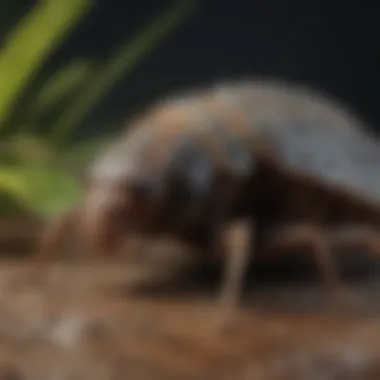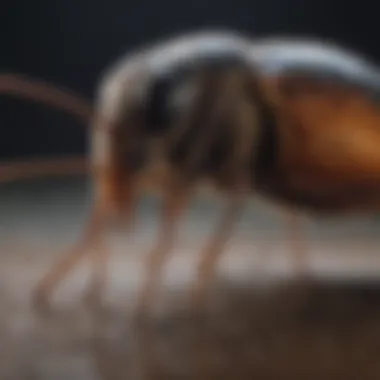Revolutionizing Pest Control: Innovative Adaptive Solutions for Sustainable Practices


Preventive Pest Control Strategies
Pest control is a crucial aspect of maintaining a healthy and comfortable home environment, especially for individuals like housewives who seek a safe and pest-free living space. Implementing preventive pest control strategies not only ensures the well-being of your loved ones but also contributes to the longevity of your property.
House Exterior Protection
When safeguarding your home against pests, paying attention to the exterior is paramount. Effective tips for sealing cracks in walls and foundations can prevent common pests such as ants and spiders from finding their way indoors. Clearing debris around your property not only enhances its aesthetics but also eliminates hiding spots for pests. Additionally, taking proactive measures to prevent pests from entering, like installing door sweeps and repairing damaged screens, is essential in fortifying your home's defenses.
Yard Maintenance
Maintaining a pest-free yard requires consistent effort and attention to detail. Essential yard care routines such as regular mowing, trimming vegetation, and removing standing water can significantly reduce pest habitat. Implementing methods like using mulch and gravel to deter pests and practicing proper waste disposal within the yard can further enhance your pest control efforts.
Indoor Cleanliness
Indoor spaces serve as havens for pests seeking food, water, and shelter. Housewives can maintain a pest-resistant environment by adopting expert cleaning tips and techniques. Regularly vacuuming carpets, wiping down surfaces, and storing food in airtight containers are simple yet effective ways to deter pests. Proper waste management inside the house, including timely disposal of trash and recycling, plays a crucial role in minimizing pest attractants.
Garbage Disposal
Efficient waste disposal methods are instrumental in preventing pest infestations. Properly sealing garbage bags, using lidded bins, and ensuring timely disposal of food waste are key practices that housewives can incorporate into their daily routines. Educating family members on the importance of adhering to garbage disposal guidelines can significantly mitigate the risk of pest entry and population growth.
Other Pest Prevention Strategies
In addition to the foundational preventive measures, exploring innovative ways to safeguard your home can elevate your pest control efforts. From utilizing natural pest repellents like citrus peels and vinegar to employing smart home technologies for early pest detection, there are various methods that housewives can embrace to create a pest-resistant living environment.
Introduction
In the ever-evolving landscape of pest control, the introduction sets the stage for the transformation towards adaptive solutions. This pivotal section paves the way for understanding the crucial shift occurring within the pest management domain. As we delve into the realm of adaptive pest control, it becomes apparent that traditional methods are no longer sufficient in combating the dynamic challenges posed by pests. The significance of this introduction lies in unraveling the core principles, benefits, and considerations surrounding adaptive pest control, offering a holistic view of the approaches poised to revolutionize pest management practices.
Evolution of Pest Control Practices
The historical context of pest management
The historical context of pest management holds a wealth of knowledge that shapes our understanding of past pest control practices. By examining historical pest management strategies, we gain valuable insights into the origins of modern-day approaches. Understanding the historical evolution of pest control allows us to appreciate the progress made in adaptive solutions. This historical narrative serves as a foundation for analyzing the effectiveness of traditional methods and their relevance in the current scenario. While traditional practices have been instrumental in pest control, they also pose limitations in addressing contemporary pest challenges, emphasizing the need for adaptive measures.
Challenges posed by traditional pest control methods


Traditional pest control methods have long prevailed in combating pest infestations, yet they confront inherent challenges. These challenges range from environmental concerns to pesticide resistance, underscoring the drawbacks associated with conventional approaches. Despite their efficacy in the past, traditional methods exhibit limitations in coping with the nuanced dynamics of modern-day pests. The drawbacks of traditional pest control methods necessitate a paradigm shift towards adaptive pest control, fostering sustainable and effective solutions that align with evolving pest scenarios.
Emergence of Adaptive Pest Control
Defining adaptive pest control
As we embark on the era of adaptive pest control, defining the essence of adaptability becomes paramount. Adaptive pest control encompasses a dynamic approach that responds to changing pest populations and environmental conditions. This responsiveness allows for tailored interventions based on real-time data, enhancing the precision and efficacy of pest management strategies. The adaptability embedded within this approach empowers pest control practitioners to proactively address emerging pest challenges with agility and foresight.
Impact of climate change on pest dynamics
The unifying force of climate change has significantly altered pest dynamics, heralding a new era rife with challenges and opportunities. The impact of climate change on pest dynamics underscores the intricate interplay between environmental shifts and pest behaviors, leading to unprecedented pest proliferation. By recognizing the influence of climate change on pest populations, adaptive pest control strategies can mitigate the repercussions of ecological imbalances and foster resilience in pest management. Harnessing data-driven insights, adaptive solutions can anticipate and mitigate the intricate interplay between climate variables and pest dynamics, fortifying pest control efforts for a sustainable future.
Technological Innovations
In the landscape of pest control, Technological Innovations play a pivotal role in transforming traditional practices into cutting-edge solutions. This section delves into the intersection of technology and pest management, highlighting the significance of integrating innovative tools for enhanced efficiency and sustainability. By embracing technological advancements, the pest control industry is ushering in a new era of adaptive strategies that promise more effective outcomes while reducing environmental impact.
Io
T Integration in Pest Monitoring
Role of Io
T sensors in early detection
IoT sensors revolutionize pest monitoring by providing real-time data on pest activities, enabling early detection of infestations. These sensors serve as proactive surveillance tools, swiftly identifying pest presence and allowing for prompt intervention measures. Their ability to continuously monitor and transmit information facilitates timely responses, minimizing potential damages and operational costs. The Role of IoT sensors in early detection is a cornerstone of adaptive pest control, empowering practitioners with actionable insights to implement targeted management practices effectively.
Data-driven pest management strategies
Data-driven pest management strategies leverage IoT-generated data to formulate proactive and tailored interventions. By analyzing patterns and trends, practitioners can develop predictive models to anticipate pest behavior and optimize control measures. This data-centric approach enhances decision-making processes, streamlining operations and maximizing resource allocation efficiency. Despite its complexity, Data-driven pest management strategies yield sustainable benefits by enabling precision-based solutions that harmonize ecological preservation with effective pest control measures.
AI and Machine Learning Applications
Advancements in AI and Machine Learning bring a paradigm shift to pest control practices through predictive analytics and precision targeting.
Predictive analytics for pest outbreaks
The integration of predictive analytics enables the early anticipation of potential pest outbreaks based on historical data and environmental factors. By identifying risk zones and vulnerabilities, predictive analytics empower proactive measures to mitigate pest pressures before they escalate. This preemptive approach minimizes the need for reactive interventions, promoting long-term pest control sustainability. The predictive power of analytics optimizes resource efficiency and enhances overall pest management efficacy, making it a valuable tool in the arsenal of adaptive pest control.


Precision targeting of pest populations
AI and Machine Learning enable precise targeting of pest populations by analyzing intricate pest dynamics and identifying optimal intervention strategies. This targeted approach minimizes collateral damage to non-target organisms and reduces the use of chemical pesticides, promoting environmentally friendly pest control practices. Precision targeting not only increases the effectiveness of pest management but also contributes to biodiversity conservation by preserving natural predator-prey relationships. The refining capabilities of AI algorithms in pest targeting reaffirm the importance of adopting sophisticated technological solutions in modern pest control methodologies.
Drones in Pest Surveillance
The utilization of drones in pest surveillance revolutionizes traditional monitoring approaches by offering aerial perspectives for efficient pest detection and mapping.
Unmanned aerial vehicles for monitoring
Drones serve as unmanned aerial vehicles that cover expansive terrains rapidly, providing high-resolution imaging for detailed pest surveillance. Their versatility and maneuverability enable precise monitoring of remote areas, inaccessible to ground-based systems. By capturing real-time data on pest activities, drones enhance early detection capabilities, facilitating timely intervention strategies. The autonomous nature of drones enhances operational efficiency in pest surveillance, offering a bird's eye view for targeted pest management efforts.
Efficient mapping of infestation patterns
Drones facilitate the efficient mapping of infestation patterns by generating systematic aerial surveys that highlight pest hotspots and distribution areas. Through infrared technology and specialized cameras, drones capture thermal signatures and visual cues indicative of pest presence, enabling spatial analysis for effective control measures. The ability to overlay survey data onto geographical maps enhances decision-making processes, guiding practitioners in strategizing pest control interventions with pinpoint accuracy. The intricate mapping capabilities of drones elevate pest surveillance to a sophisticated level, presenting a compelling case for adopting drone technology in modern pest management strategies.
Biological Controls
Biological controls play a crucial role in revolutionizing pest control by offering sustainable and eco-friendly solutions. In this article, we delve into the significance of biological controls as a key component of adaptive pest management strategies. By utilizing natural mechanisms to regulate pest populations, biological controls contribute to a more balanced and environmentally conscious approach.
Beneficial Insects for Pest Regulation
Introduction of Predator Insects
The introduction of predator insects is a fundamental aspect of biological pest control. These beneficial insects act as natural enemies to harmful pests, aiding in the suppression of pest populations without the need for chemical interventions. The key characteristic of introducing predator insects lies in their ability to effectively target and control specific pest species, offering a targeted and sustainable solution. Their unique feature of natural predation ensures a non-toxic approach to pest management, making them a popular choice for integrated pest control programs. While advantageous in reducing reliance on pesticides and minimizing environmental impact, a potential disadvantage of using predator insects is the need for proper species selection and management to prevent disruptions to the ecosystem.
Biological Pest Suppression Mechanisms
Biological pest suppression mechanisms represent the natural processes through which beneficial organisms control pest populations. By utilizing predatory, parasitic, or disease-causing organisms, biological control methods disrupt pest reproduction and survival, ultimately leading to pest suppression. The key characteristic of these mechanisms is their ability to uphold ecological balance by mimicking natural relationships within ecosystems. This biocontrol approach is popular for its targeted action against pests, reducing the likelihood of developing pest resistance. However, a potential challenge lies in the slower impact compared to conventional chemical control methods. Despite this, biological pest suppression mechanisms offer long-term sustainability and environmental benefits, making them a valuable asset in adaptive pest control strategies.
Microbial Agents in Pest Management
Utilization of Biopesticides
The utilization of biopesticides involves harnessing microbial agents to control pest populations while minimizing harm to non-target organisms and the environment. Biopesticides offer a bio-rational approach to pest management, utilizing naturally occurring microorganisms such as bacteria, viruses, and fungi to combat pests. The key characteristic of biopesticides lies in their specificity towards target pests, ensuring minimal impact on beneficial insects and other organisms. This eco-friendly approach is a popular choice for organic farming practices and integrated pest management strategies. While biopesticides provide effective pest control with reduced chemical residues, a potential disadvantage includes the variability of efficacy depending on environmental conditions and pest species.


Microbial Biocontrol for Sustainable Outcomes
Microbial biocontrol represents a sustainable approach to pest management, focusing on the long-term regulation of pest populations using microbial agents. By introducing beneficial microorganisms into pest habitats, microbial biocontrol aims to establish a natural balance that suppresses pest activity. The key characteristic of microbial biocontrol is its application of naturally occurring antagonistic microbes to target specific pests while maintaining environmental safety. This method is a beneficial choice for sustainable agriculture practices, promoting biodiversity and minimizing negative impacts on ecosystems. However, challenges may arise in the formulation and stability of microbial agents, impacting their persistence and efficacy in varying environmental conditions. Despite this, microbial biocontrol offers a promising avenue for achieving sustainable outcomes in pest management.
Sustainable Practices
In this pivotal section, we delve into the foundational principles of sustainable practices within the context of adaptive pest control. Sustainable practices stand at the forefront of combating pests while preserving the ecosystem's delicate balance. By embracing sustainable methods, we aim to achieve long-term pest management solutions without compromising the environment's integrity. Sustainability in pest control encompasses a range of strategies that minimize harm to beneficial insects, animals, and plants while effectively controlling pest populations. The amalgamation of innovative technologies and environmentally conscious practices marks a paradigm shift in the pest control industry towards a more holistic and eco-friendly approach.
Integrated Pest Management (IPM)
Principles of IPM: Exploring the intricate web of Integrated Pest Management unveils a systematic and comprehensive strategy that emphasizes proactive pest control measures. The core principle of IPM revolves around the strategic integration of multiple control tactics to manage pests effectively. By promoting a multifaceted approach that includes biological, cultural, physical, and mechanical controls, IPM minimizes reliance on chemical interventions. This approach fosters a sustainable pest control ecosystem by encouraging natural pest predator-prey relationships and reducing the likelihood of pesticide resistance. The beauty of IPM lies in its adaptability to diverse agroecosystems, making it a versatile and efficient choice for sustainable pest management.
Reducing reliance on chemical interventions: Straying away from traditional chemical-centric pest control methods, the emphasis on reducing reliance on pesticides constitutes a cornerstone of sustainable practices. By harnessing the power of non-chemical interventions such as biological controls, habitat manipulation, and crop rotation, we mitigate the negative impact of pesticides on the environment and human health. This shift towards minimizing chemical usage not only preserves beneficial insect populations but also contributes to the overall health of the ecosystem. However, the transition towards reducing chemical interventions may pose challenges in certain scenarios where immediate pest control is essential, necessitating a delicate balance between efficacy and environmental preservation.
Organic Pest Control Methods
Use of natural repellents: One of the fundamental aspects of organic pest control involves leveraging natural repellents derived from plant extracts or essential oils. Natural repellents act as deterrents for pests, disrupting their feeding and reproductive behaviors without causing harm to beneficial organisms. The key characteristic of natural repellents lies in their non-toxic nature, making them a safe and sustainable choice for pest management. These repellents offer a botanical solution to pest problems, promoting a harmonious relationship between agricultural practices and the environment.
Organic farming practices for pest mitigation: Organic farming practices introduce holistic approaches to pest control by enhancing soil health, promoting biodiversity, and reducing chemical inputs. By incorporating techniques such as crop rotation, intercropping, and the use of beneficial insects, organic farming mitigates pest pressures naturally. The unique feature of organic farming lies in its ability to maintain ecosystem balance while effectively managing pest populations. While organic practices offer numerous environmental and health benefits, they might require increased labor and monitoring compared to conventional methods. However, the long-term benefits of sustainable pest management and improved soil quality make organic farming practices a prudent choice for eco-conscious individuals seeking pest control solutions.
Future Perspectives
In the landscape of adaptive pest control methods, looking towards the future is vital. Future perspectives offer insights into the potential advancements that could shape the industry, emphasizing sustainability and efficiency. By considering the evolving challenges in pest management, it becomes evident that staying ahead of the curve is paramount. Embracing new technologies, sustainable practices, and innovative approaches will define the success of pest control strategies moving forward. The future perspectives section serves as a guidepost for practitioners and researchers alike, highlighting the importance of continuous innovation and adaptation to address the dynamic nature of pest dynamics.
Advancements in Genetic Pest Modulation
Crispr-Cas9 technology for pest population control
Crispr-Cas9 technology represents a groundbreaking approach to pest population control, offering precise manipulation of genetic material in targeted pest species. This technology's key characteristic lies in its ability to modify specific genes within pest populations, thereby disrupting their reproductive capabilities or altering their behaviors. The unique feature of Crispr-Cas9 technology is its unparalleled precision, enabling researchers to tailor interventions to meet specific pest management goals. While the advantages of Crispr-Cas9 technology are noteworthy, including its potential to reduce pesticide usage and minimize environmental impact, ethical considerations surrounding its application warrant careful deliberation.
Ethical considerations in genetic pest management
Ethical considerations play a crucial role in the adoption of genetic pest management strategies. As the intersection between technology and biology expands, ethical frameworks must ensure that interventions are not only effective but also uphold principles of welfare and sustainability. Key characteristics of ethical considerations in genetic pest management entail preserving biodiversity, minimizing unintended consequences, and ensuring transparency in decision-making processes. While the unique feature of integrating ethics into genetic pest management promotes holistic pest control solutions, balancing the benefits and risks associated with this approach remains a critical aspect to consider. Navigating the ethical landscape of genetic pest management requires a harmonious alignment between scientific progress and moral obligations, paving the way for responsible innovation in pest control.
Smart Urban Planning for Pest Prevention
Urban design impact on pest habitats
Urban design significantly influences pest habitats, shaping the environment in which pests thrive or struggle to survive. The key characteristic of urban design impact lies in its ability to either exacerbate or alleviate pest infestations by manipulating landscape features, accessibility to resources, and human-animal interactions. Choosing sustainable and pest-resilient urban design elements can synergistically enhance pest prevention strategies, promoting ecosystem health while mitigating pest pressures. The unique feature of urban design impact is its adaptability to incorporate green spaces, natural barriers, and integrated pest management practices seamlessly into urban landscapes, fostering a harmonious coexistence between humans and pests.
Green infrastructure for pest resilience
Green infrastructure offers a proactive approach to bolstering pest resilience within urban environments, emphasizing natural solutions and ecosystem services to manage pest populations. The key characteristic of green infrastructure lies in its capacity to provide habitat diversity, food sources, and refuge for natural enemies of pests, fostering ecological balance and reducing the need for chemical interventions. Choosing green infrastructure for pest resilience not only enhances urban biodiversity but also contributes to the overall health and sustainability of urban ecosystems. The unique feature of green infrastructure is its multipurpose functionality, serving as a cost-effective and environmentally friendly strategy to tackle pest-related challenges in urban settings. While the advantages of green infrastructure are evident, such as promoting biological pest control and enhancing urban aesthetics, careful planning and monitoring are essential to maximize its benefits and minimize potential drawbacks in pest management strategies.



